Content for TS 23.255 Word version: 19.4.0
7.11 UAE layer support for NTZ
7.11.1 General
7.11.2 Procedures
7.11.2.1 Management of NTZ support configuration
7.11.2.2 NTZ configuration
7.11.2.3 NTZ activation by UAE Client
7.11.2.4 UAE-layer/SEAL/LMS assisted NTZ enforcement
7.11.2.5 New USS NTZ policy
7.11.3 Information flows
7.11.3.1 NTZ management request
7.11.3.2 NTZ management response
7.11.3.3 NTZ management complete
7.11.3.4 NTZ configuration request
7.11.3.5 NTZ configuration response
7.11.3.6 NTZ notification
7.11.3.7 New NTZ policy request
7.11.3.8 New NTZ policy response
7.11.3.9 Enforce NTZ request
7.11.3.10 Enforce NTZ response
...
...
7.11 UAE layer support for NTZ |R19| p. 83
7.11.1 General p. 83
This feature enables the UAS application enablement services for assisting the UAS application with NTZ handling. The UAE layer provides support for the following operations:
- Support the management of NTZ between the UAS application specific server and UAE server as described in clause 7.11.2.1.
- Support the distribution of the NTZ application policy from UAS application specific server to the UAE server and the UAE client as described in clause 7.11.2.1 and 7.11.2.2.
- Support for informing the UAE server and UAS application specific server about NTZ status changes at the UAV as described in clause 7.11.2.3.
- Support the UAE layer assisted NTZ as described in clause 7.11.2.4.
- Support the UAE client in obtaining new NTZ information after changing USS as described in clause 7.11.2.5.
7.11.2 Procedures p. 83
7.11.2.1 Management of NTZ support configuration p. 83
Figure 7.11.2.1-1 illustrates the NTZ support management procedure where the UAE server receives an application request for managing the NTZ application policy from the UAS application specific server.
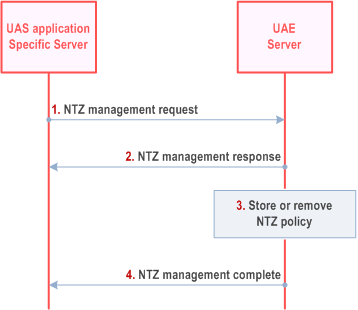
Step 1.
The UAS application specific server sends to the UAE server a NTZ management request. The request includes the UASS identifier and the NTZ policy management container. If NTZ policy container is provided, the request shall include area for deactivating transmission, information about frequency bands and reporting configuration.
Step 2.
The UAE Server sends to the UAS application specific server a NTZ management response with a positive or negative acknowledgement of the request, based on capability of UAE server to undertake this task.
Step 3.
UAE server executes NTZ configuration according to clause 7.11.2.2.
Step 4.
After execution of NTZ configuration, the UAE server notifies the UAS application specific server with a NTZ management complete.
7.11.2.2 NTZ configuration p. 84
This procedure enables the configuration of the UAE Client, based on an application request from UAS application specific server (which can be the USS/UTM) to manage the NTZ for a UAS.
Figure 7.11.2.2-1 illustrates the NTZ configuration procedure.
Pre-conditions:
- The UAS UEs are connected to 5GS and authenticated and authorized by UAS application specific server as specified in clause 5.2 of TS 23.256.
- UAE Server has established a UAE session with the respective UAE clients as the UAE clients are successfully registered to the UAE server.
- UAE Server has performed the NTZ management as in clause 7.11.2.1.
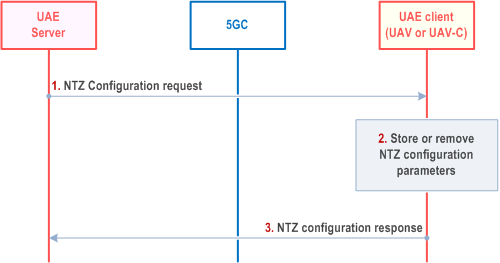
Step 1.
The UAE Server sends a NTZ configuration request including the UAS identifier. If the NTZ configuration is provided, the request shall include the area for deactivating transmission, frequency bands and reporting configuration. The UAE server configures all UAS UEs registered in the UAE server.
Step 2.
The UAE Client stores or removes the NTZ configuration parameters as per the information received in step 1.
Step 3.
The UAE Client sends a NTZ configuration response to the UAE Server.
7.11.2.3 NTZ activation by UAE Client p. 85
This procedure provides a mechanism for the UAE client to deactivate and activate its radio transmission in the respective frequency bands when entering or leaving the NTZ area based on the NTZ configuration as described in clause 7.11.2.2.
Figure 7.11.2.3-1 illustrates the NTZ activation.
Pre-conditions:
- The UAE Clients are configured with a NTZ configuration as described in clause 7.11.2.2.
- UAE Server has performed the NTZ management, as described in clause 7.11.2.1.
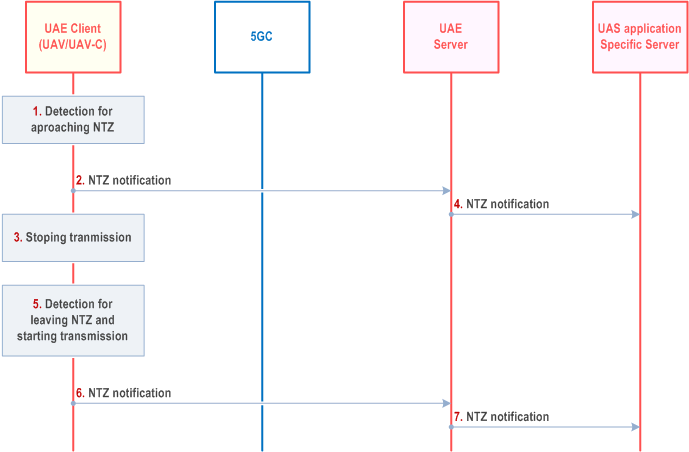
Step 1.
UAE Clients (UAV and UAV-C) detect approaching area for deactivating transmission based on their NTZ configuration. Upon entering the NTZ area, the UAE client can switch to another frequency band or entirely stop its transmission depending on its available functionality and NTZ configuration.
Step 2.
The UAE Client sends a NTZ notification to the UAE Server indicating "NTZ imminent entry" and the time for switching off the needed frequency band and its location.
Step 3.
The UE clients stop its transmission.
Step 4.
The UAE Server forwards the NTZ notification to the UAS application specific server. It contains the UAS identity, the time for switching transmission off and location information of the UAS.
Step 5.
The UAE client detects it is out of the area for deactivating transmission and starts transmission.
Step 6.
The UAE client sends a NTZ notification to the UAE server indicating "NTZ exit" and the time for switching on the respective frequency band and its location.
Step 7.
The UAE Server forwards the NTZ notification to the UAS application specific server. It contains the UAS identity, the specific time when the transmission has been switched on and location information of the UAS.
Step 8.
In case that the UAE client has changed its USS according to clause 7.6 then:
Step 9.
UAE client requests new USS NTZ policy from the UAE server.
Step 10.
The UAE server replies with the new USS NTZ policy.
7.11.2.4 UAE-layer/SEAL/LMS assisted NTZ enforcement p. 86
This procedure provides a mechanism for supporting NTZ activation and deactivation based on usage of existing SEAL/LMS functionality for monitoring location deviation specified in clause 9.3.11 of TS 23.434. The responsibility of following the NTZ policy is in UAV/UAV-C.
Figure 7.11.2.4-1 illustrates the procedure where the UAE server and SEAL/LMS support the assisted NTZ enforcement.
Pre-conditions:
- UAE Server has performed the NTZ management, as described in clause 7.11.2.1.
- UAE Server has subscribed for using SEAL/LMS services.
- UAE Server has established a UAE session with the respective UAE clients as the UAE clients are successfully registered to the UAE server.
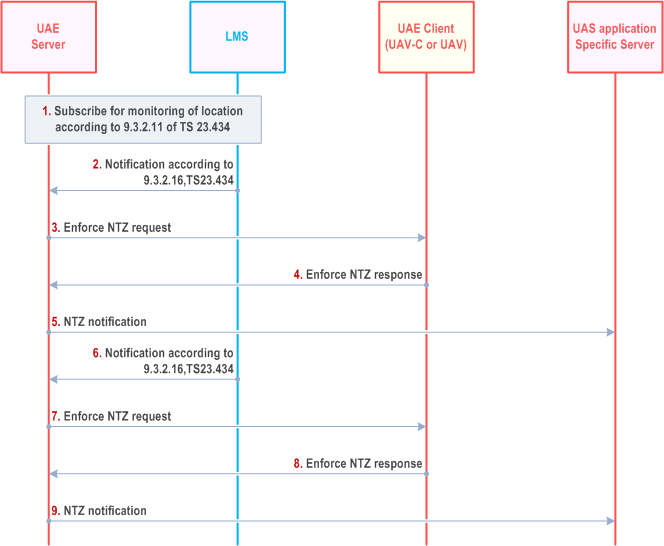
Step 1.
The UAE server subscribes for monitoring of location deviation according to clause 9.3.2.11 of TS 23.434 using the identities of the UAE client successfully registered to the UAE server. The area of interest is the geographical area in which the no-transmit zone is active.
Step 2.
If one or more of the monitored UAE clients enter the area of interest, the LMS sends location area monitoring notification according to clause 9.3.2.16 of TS 23.434 containing the UAE client identifiers.
Step 3.
The UAE Server sends enforce NTZ request to the identified UAE clients entering the area of interest, indicating to stop transmission and containing information about the NTZ (area for deactivating the transmission, frequency bands, altitude). It is up to UAE client and UAV to switch its transmission on the specified NTZ frequency.
Step 4.
The UAE clients send enforce NTZ response to the UAE server indicating positive or negative result of the received request.
Step 5.
The UAE server sends NTZ notification towards the UAS application specific server. It contains the UAS identity, the specific time when the transmission has been switched off and location information of the UAS.
Step 6.
If one or more of the monitored UAE clients leaves the area of interest, the LMS sends location area monitoring notification according to clause 9.3.2.16 of TS 23.434 containing the UAE client identifiers.
Step 7.
The UAE Server sends enforce NTZ request to the identified UAE clients leaving the area of interest, indicating to start transmission.
Step 8.
The UAE clients send enforce NTZ response to the UAE server indicating positive or negative result of the received request.
Step 9.
The UAE server sends NTZ notification towards the UAS application specific server. It contains the UAS identity, the specific time when the transmission has been switched on and location information of the UAS.
7.11.2.5 New USS NTZ policy p. 87
This procedure provides a mechanism for the UAE client to request a new NTZ policy when a change of USS happens.
Figure 7.11.2.5-1 illustrates the new NTZ policy.
Pre-conditions:
- The UAE Clients are configured with a NTZ configuration as described in clause 7.11.2.2.
- UAE Server has performed the NTZ management, as described in clause 7.11.2.1.
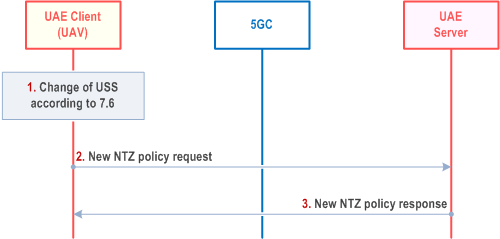
Step 1.
The UAE client has changed its USS according to the procedures described under clause 7.6.
Step 2.
UAE client requests new NTZ policy from the UAE server.
Step 3.
The UAE server replies with the new NTZ policy.
7.11.3 Information flows p. 87
7.11.3.1 NTZ management request p. 87
Table 7.11.3.1-1 describes the information flow NTZ management request from the UAS application specific server to the UAE server.
| Information element | Status | Description |
|---|---|---|
| UASS ID | M | Identity of the UAS application specific server which requests the NTZ management. This ID can be the USS identifier, when the UAS application specific server is the USS. |
| NTZ policy management container (see NOTE) | O | The NTZ policy management container consists of the requirements and policy for NTZ management. |
| > Area for deactivating transmission | M | The area where the NTZ management request applies. This can be geographical area, or topological area in which the no-transmit zone is active including specific altitude. |
| > Time period | M | The time period when the NTZ is valid. |
| > Frequency bands | M | The information for the frequency bands not allowed to be used in NTZ. |
| >Reporting configuration | M | The NTZ reporting configutation of the the UE, including the required reporting (e.g., prior to entering or after exiting or both) and the time interval for reporting. |
|
NOTE:
If NTZ policy management container is not included, it indicates removal of the NTZ policy management related information.
|
||
7.11.3.2 NTZ management response p. 88
Table 7.11.3.2-1 describes the information flow NTZ management response from the UAE server to the UAS application specific server.
| Information element | Status | Description |
|---|---|---|
| Result | M | The positive or negative result of the NTZ management request. |
7.11.3.3 NTZ management complete p. 88
Table 7.11.3.3-1 describes the information flow NTZ management complete from the UAE server to the UAS application specific server.
| Information element | Status | Description |
|---|---|---|
| Result | M | The positive or negative result of the NTZ configuration. |
7.11.3.4 NTZ configuration request p. 88
Table 7.11.3.4-1 describes the information flow NTZ configuration request from the UAE server to the UAE client.
| Information element | Status | Description |
|---|---|---|
| UAS ID | M | The identification of the UAS for which the NTZ configuration request applies. This could be in form of identifier for the UAS, e.g. group ID; or collection of individual identifiers for the UAV and UAV-C, e.g. CAA level UAV ID, GPSI. |
| NTZ configuration (see NOTE) | O | NTZ configuration information to be configured at the UAS. |
| > Area for deactivating transmission | M | The area where the NTZ management request applies. This can be geographical area, or topological area in which the no-transmit zone is active including specific altitude. |
| > Time period | M | The time period when the NTZ is valid. |
| > Frequency bands | M | The information for the frequency bands not allowed to be used in no-transmit zone. |
| >Reporting configuration | M | The NTZ reporting configuration of the UE, including the required reporting (e.g., prior to entering or after exiting or both) and the time interval for reporting. |
|
NOTE:
If NTZ configuration IE is not included, it indicates removal of the NTZ configuration at the UAS ID.
|
||
7.11.3.5 NTZ configuration response p. 89
Table 7.11.3.5-1 describes the information flow NTZ configuration response from the UAE client to the UAE server.
| Information element | Status | Description |
|---|---|---|
| Result | M | The positive or negative result of reception and storing or removal of the NTZ configuration parameters. |
7.11.3.6 NTZ notification p. 89
Table 7.11.3.6-1 describes the information flow NTZ notification.
| Information element | Status | Description |
|---|---|---|
| UAS ID | M | The identification of the UAS. This could be in form of identifier for the UAS, e.g. group ID; or collection of individual identifiers for the UAV and UAV-C, e.g. CAA level UAV ID, GPSI. |
| NTZ status | M | The status of the NTZ enforcement; the status can be "NTZ imminent entry" or "NTZ exit". |
| NTZ Transmission information | M | Indication for the transmission change; the information indicates whether the transmission is switched on or off and includes the frequency band information. |
| Time | M | The specific time when the notification is sent. |
| Location information | M | Location and altitude of the UAE client when the notification is sent. |
| NTZ enforcement time | O | The information about the NTZ enforcement time. |
| > estimated start time
(NOTE 1) | O | The time the NTZ enforcement is expected to start. |
| > estimated completion time
(NOTE 1) | O | The time the NTZ enforcement is expected to end. |
| > actual completion time
(NOTE 2) | O | The time the NTZ enforcement completed. |
|
NOTE 1:
Mandatory if the NTZ status is for "NTZ imminent entry".
NOTE 2:
Mandatory if the NTZ status is for "NTZ exit".
|
||
7.11.3.7 New NTZ policy request p. 90
Table 7.11.3.7-1 describes the information flow new NTZ policy request from the UAE client to the UAE server.
| Information element | Status | Description |
|---|---|---|
| UAS ID | M | The identification of the UAS. This could be in form of identifier for the UAS, e.g. group ID; or collection of individual identifiers for the UAV and UAV-C, e.g. CAA level UAV ID, GPSI. |
| Location information | M | Location and altitude of the UAE client when the request is sent. |
7.11.3.8 New NTZ policy response p. 90
Table 7.11.3.8-1 describes the information flow new NTZ policy response from the UAE server to the UAE client.
| Information element | Status | Description |
|---|---|---|
| UAS ID | M | The identification of the UAS for which the NTZ configuration request applies. This could be in form of identifier for the UAS, e.g. group ID; or collection of individual identifiers for the UAV and UAV-C, e.g. CAA level UAV ID, GPSI. |
| NTZ configuration | O | NTZ configuration information to be configured at the UAS. |
| > Area for deactivating transmission | M | The area where the NTZ management request applies. This can be geographical area, or topological area in which the no-transmit zone is active including specific altitude. |
| > Time period | M | The time period when the NTZ is valid. |
| > Frequency bands | M | The information for the frequency bands not allowed to be used in no-transmit zone. |
| >Reporting configuration | M | The NTZ reporting configuration of the UE, including the required reporting (e.g., prior to entering or after exiting or both) and the time interval for reporting. |
7.11.3.9 Enforce NTZ request p. 91
Table 7.11.3.9-1 describes the information flow enforce NTZ request from the UAE server to the UAE client.
| Information element | Status | Description |
|---|---|---|
| UAS ID | M | The identification of the UAS for which the NTZ configuration request applies. This could be in form of identifier for the UAS, e.g. group ID; or collection of individual identifiers for the UAV and UAV-C, e.g. CAA level UAV ID, GPSI. |
| NTZ enforcement information (see NOTE) | O | NTZ enforcement information to be executed at the UAS. |
| > Area for deactivating transmission | M | The area where the NTZ management request applies. This can be geographical area, or topological area in which the no-transmit zone is active. |
| >Altitude | M | Altitude range for the NTZ. |
| > Time | M | Specific time window for deactivating the transmission. |
| > Frequency bands | M | The information for the frequency bands not allowed to be used in no-transmit zone. |
|
NOTE:
If NTZ enforcement information IE is not included, it indicates removal of the NTZ enforcement at the UAS ID.
|
||
7.11.3.10 Enforce NTZ response p. 91
Table 7.11.3.10-1 describes the information flow enforce NTZ response from the UAE client to the UAE server.
| Information element | Status | Description |
|---|---|---|
| Result | M | The positive or negative result of the enforce NTZ request. |